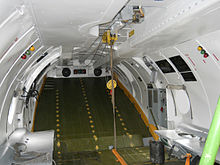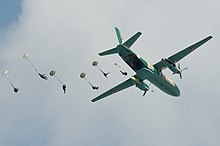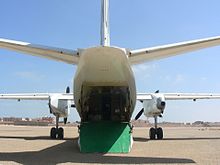Antonov An-26
| Antonov An-26 | |
|---|---|

|
|
| Type: | Military transport plane |
| Design country: | |
| Manufacturer: | |
| First flight: |
May 21, 1969 |
| Production time: |
1969 to 1986 |
| Number of pieces: |
1,403 |
The Antonov An-26 ( NATO designation : Curl ) is a tactical combat zone transporter developed primarily for military use by the Ukrainian (formerly Soviet ) design office O. K. Antonow from the 1960s. It is based on the Antonov An-24, which was primarily designed for civilian transport tasks .
history
The An-26 was developed as a light transport aircraft and was intended for use on short and medium-haul routes. The first serial machine № 03-01 left the factory on August 29, 1969. In 1983, the People's Republic of China began production under license as the Y-7H (also initially Y-14-100). Under the name An-50 , an An-26 equipped with four jet engines was planned, but it did not get beyond the project stage. The successor type An-32 , which has been in production since 1976, was developed especially for high-altitude and hot airfields . Largely identical to the An-26, more powerful engines and larger propellers enable a higher payload, among other things.
construction

Compared to the An-24, the cabin floor and landing gear have been reinforced. The rear fuselage has been completely redesigned. A loading ramp is built into the rear of the fuselage. On both sides of the rear loading hatch there are two stabilizing fins to improve directional stability. The large rear hatch allows bulky goods and small vehicles to be loaded quickly. By lowering the loading hatch, the vehicles can drive directly into the loading space. In a second opening variant, the ramp can be driven under the fuselage. In this position, loads or parachutists can be dropped during the flight. This variant also facilitates loading and unloading work on the ground, for example from a truck. The loading and unloading work is facilitated by a hoist (2,000 kg) on the ceiling of the loading space, a conveyor belt built into the loading space floor and a spill . Passengers or parachutists can be transported on the folding seats on both sides of the hold.
There are also saloon variants with a partition wall for the transport of people and freight.
An additional jet engine (RU-19A-300) was installed in the right engine nacelle . It serves as a take-off turbine, support when approaching and departing from high places, as a climbing aid, etc.
On the left side of the fuselage in the cockpit segment, a bubble-shaped observation window (blister) is installed at the workstation of the navigator. A visor built into the blister helps with lowering tasks and navigational calculations. The An-26B does not have a blister.
variants
- An-26 ("Curl-A"): Basic variant as a tactical combat zone transporter
- An-26B : This variant, introduced in 1981, also has roller rails in the hold, which are stowed in the fuselage when not in use. In addition, the more powerful SMKB Progress (Ivchenko) Al-24WT turboprop engine is used
- An-26BRL : variant for reconnaissance over the Arctic
- An-26L : variant for airfield calibration
- An-26M : variant as an ambulance aircraft
- An-26P : Fire fighting variant with tanks in the fuselage
- An-26RTR : variant for EKF ( ELINT , SIGINT and electronic warfare)
- An-26ST : Special variant for the NVA. Salon version with passenger compartment (12 seats, 2 tables)
- Y-7H : The copy of the An-26 military cargo plane made in China by Xi'an Aircraft Industry Company (XAC) is known there as the Yunshu-7
- Y-7-500 : variant of the An-26 for civil aviation, manufactured in China by Xi'an Aircraft Industry Company
Military users
Current users

-
 Afghanistan : 2
Afghanistan : 2 -
 Angola : 12
Angola : 12 -
 Ethiopia : 1
Ethiopia : 1 -
 Benin : 2 (parked)
Benin : 2 (parked) -
 Bulgaria : 3
Bulgaria : 3 -
 People's Republic of China : 27 (as Xian Y-7 )
People's Republic of China : 27 (as Xian Y-7 ) -
 Yemen : 26
Yemen : 26 -
 Cambodia : 1
Cambodia : 1 -
 Cape Verde : 3
Cape Verde : 3 -
 Kazakhstan : 1
Kazakhstan : 1 -
 Kyrgyzstan : 2
Kyrgyzstan : 2 -
 Democratic Republic of the Congo : 1
Democratic Republic of the Congo : 1 -
 Cuba : 3
Cuba : 3 -
 Laos : 3
Laos : 3 -
 Libya : 10
Libya : 10 -
 Madagascar : 4 ( Armée de l'Air Malgache )
Madagascar : 4 ( Armée de l'Air Malgache ) -
 Mali : 1
Mali : 1 -
 Moldova : 1
Moldova : 1 -
 Mongolia : 1
Mongolia : 1 -
 Mozambique : 5
Mozambique : 5 -
 Namibia : 2
Namibia : 2 -
 Nicaragua : 2
Nicaragua : 2 -
 Niger : 1
Niger : 1 -
 North Korea :
North Korea : -
 Romania : 4
Romania : 4 -
 Russia : more than 30
Russia : more than 30 -
 Zambia : 4
Zambia : 4 -
 Serbia : 8
Serbia : 8 -
 Slovakia : 2
Slovakia : 2 -
 Syria : 5
Syria : 5 -
 Turkmenistan : 10
Turkmenistan : 10 -
 Chad : 1
Chad : 1 -
 Hungary : 4
Hungary : 4 -
 Ukraine : 31
Ukraine : 31 -
 Uzbekistan : 13
Uzbekistan : 13 -
 Vietnam : 48
Vietnam : 48 -
 Belarus ( Air Force ): 6
Belarus ( Air Force ): 6
Former users
-
 Bangladesh : 2 (all retired)
Bangladesh : 2 (all retired) -
 German Democratic Republic : Air Forces of the National People's Army Germany : Air Force : 12 The NVA-LSK procured twelve An-26s from 1980 to 1986 and deployed them as part of the Transport Fliegerstaffel 24 , partly also for aid missions in Ethiopia and Mozambique. On October 3, 1990, they were taken over by the Luftwaffe (German Armed Forces) and some of them flew in Lufttransportgeschwader 65 until 1994 .
German Democratic Republic : Air Forces of the National People's Army Germany : Air Force : 12 The NVA-LSK procured twelve An-26s from 1980 to 1986 and deployed them as part of the Transport Fliegerstaffel 24 , partly also for aid missions in Ethiopia and Mozambique. On October 3, 1990, they were taken over by the Luftwaffe (German Armed Forces) and some of them flew in Lufttransportgeschwader 65 until 1994 .
-
 Guinea-Bissau : (all retired)
Guinea-Bissau : (all retired) -
 Iraq : 5 (all retired)
Iraq : 5 (all retired) -
 Yugoslavia : (passed on to subsequent states)
Yugoslavia : (passed on to subsequent states) -
 Lithuania : 3 (all retired)
Lithuania : 3 (all retired) -
 Pakistan : (all retired)
Pakistan : (all retired) -
 Peru : 22 (1977-1993)
Peru : 22 (1977-1993) -
 Poland : 12 (1972-2009)
Poland : 12 (1972-2009) -
 Somalia : 4 (all retired)
Somalia : 4 (all retired) -
 Soviet Union : (passed on to subsequent states)
Soviet Union : (passed on to subsequent states) -
 Tanzania : (all retired)
Tanzania : (all retired) -
 Czech Republic : 4 (all retired)
Czech Republic : 4 (all retired) -
 Czechoslovakia : (passed on to subsequent states)
Czechoslovakia : (passed on to subsequent states)
Incidents
From the first flight in 1969 to January 2019, there were 165 total write-offs with the Antonov An-26. In 88 of them, 1,464 people were killed. Extracts:
- On January 9, 2007, a Moldovan charter aircraft version An-26B-100 of the AerianTur-M ( aircraft registration ER-26068 ) crashed 2.5 km off the runway of the US Balad Air Base , Iraq . 34 of the 35 inmates were killed.
- On March 9, 2016, an An-26B of True Aviation (S2-AGZ) crashed three kilometers west of Cox's Bazar airport in Bangladesh while attempting to go around. Before that, the take-off had been continued on one engine despite the loss of thrust. After the engine was switched off, the master took off again on the approach for unknown reasons; this resulted in a stall . Of the four crew members, only the navigator survived.
- On October 14, 2017, an An-26-100 chartered by the French armed forces of the Moldovan Valan International Cargo Charter (ER-AVB) crashed into the sea about 650 meters from the threshold in poor weather conditions while approaching Abidjan ( Ivory Coast ) and broke into several Parts. The aircraft was 42 years old at the time of the accident. Four of the six Moldovan crew members were killed in the accident and the four French passengers were injured.
- On March 6, 2018, an An-26 of the Russian Air Force (RF-92955) crashed about 500 m from the runway while approaching the Syrian military airfield at Hmeimim at around 3 p.m. Moscow time. All military personnel of the Russian Federation on board, 33 passengers and six crew members, died (see also the crash of an Antonov An-26 in Latakia ) .
- On December 20, 2018, an An-26B of the Gomair (9S-AGB) with 7 (according to other reports 8) crew members on board, which was under way on behalf of the Central Electoral National Independent Commission (CENI) , had an accident shortly before the approach to runway 06 at Ndjili Airport ( DR Congo ), killing everyone on board. No search was started by the authorities, but the machine was found about 24 hours later by locals who confirmed the death of the crew.
Technical specifications
| Parameter | Dates An-26 |
|---|---|
| crew | 5 (NVA: 4) |
| Passengers | 39 passengers or 30 paratroopers |
| length | 23.80 m |
| span | 29.20 m |
| height | 8.75 m |
| Wing area | 74.98 m² |
| Wing extension | 11.4 |
| Empty mass | 15,020 kg |
| payload | Max. 5,500 kg |
| Takeoff mass | normal 23,000 kg; Max. 24,000 kg |
| Landing mass | Max. 24,000 kg |
| Rolling compound | Max. 24,250 kg |
| drive |
|
| Top speed | 680 km / h at 8,000 m |
| Cruising speed | 435 km / h in 6,000 m (with normal takeoff mass) |
| Service ceiling | 8,100 m |
| Range | 900 km with 4,500 kg payload |
Armament
If necessary, four suspension stations can be attached to the side in the lower fuselage segment, which turns the transporter into an auxiliary bomber or armed patrol pilot. The armament is up to 1,000 kg at four external load stations attached to the side of the fuselage and consists of unguided air-to-ground missiles or unguided free-fall bombs:
- 2 × UB-32A-57 rocket tube launch containers for 32 unguided air-to-surface missiles of the type S-5 in caliber 57 mm
- 4 × FAB-250 (250 kg free fall bomb )
An-26 in museums
- Germany
- An-26ST, BW 52 + 04 , ex NVA 375 ( DDR – SBN ), exhibited in the Technikmuseum Speyer . With a subsequent white and red fantasy paint job and a Chaika limousine in the hold , this aircraft is incorrectly declared as Erich Honecker's private plane.
- An-26, BW 52 + 05 , ex NVA 376 ( GDR – SBD ), exhibited in the Swabian Farming and Technology Museum , Eschach-Seifertshofen
- An-26, BW 52 + 08 , ex NVA 368 ( GDR – SBB ), exhibited in the flight exhibition L. + P. Hermeskeil
- An-26 (M), BW 52 + 09 , ex NVA 369 ( DDR – SBL ), exhibited in the Military History Museum at Berlin-Gatow airfield
- Poland
- An-26 "1509", exhibited in the Polish Aviation Museum in Krakow .
- An-26 "1602", exhibited in the Museum of the Polish Army in Warsaw .
Web links
- Type certification of the Antonov 26 - EASA-TCDS-A.351 (PDF; 357 kB)
- The Antonov An-26 - used in two German air forces
- Fliegerrevue 02/87 ( Memento from June 13, 2014 in the Internet Archive ) - NVA paratroopers jump out of the An-26 for the first time
- An-26.com Comprehensive An-26 page: complete documentation, catalogs, detailed history, drawings, manuals, etc. (Russian)
- Photo gallery with detailed views on EnglishRussia.com (English)
Individual evidence
- ↑ Accident statistics Antonov An-26 , Aviation Safety Network (English), accessed on February 1, 2019.
- ^ Accident report AN-26 ER-26068, Aviation Safety Network (English), accessed on March 24, 2016.
- ↑ Flight International, May 2, 2017 (English), p. 12.
- ↑ Ulrich Klee, Frank Bucher et al .: jp airline-fleets international 2013/14 . Sutton, UK, 2013, p. 141.
- ↑ Aircraft accident data and report AN-26 ER-AVB in the Aviation Safety Network (English), accessed on November 11, 2017.
- ↑ Accident: Valan AN26 at Abidjan on Oct 14th 2017, came to stop in the sea. The Aviation Herald, October 14, 2017, accessed October 16, 2017 .
- ^ Accident report An-26 RF-92955 , Aviation Safety Network (English), accessed on March 7, 2018.
- ↑ В Сирии разбился российский транспортный самолет. RIA Novosti , March 6, 2018, accessed March 6, 2018 (Russian).
- ↑ Генсек ОДКБ выразил соболезнования в связи с крушением Ан-26 в Сирии. RIA Novosti, March 7, 2018, accessed March 7, 2018 (Russian).
- ^ Accident report AN-26B 9S-AGB , Aviation Safety Network (English), accessed on February 1, 2019.
- ↑ David Donald: Airplane types of the world . Models - technology - data. Bechtermünz, Augsburg 1997, ISBN 3-86047-593-2 , p. 56, 57 (American English: The encyclopedia of world aircraft . Translated by Thema Produktmarketing und Werbung mbH, Munich).
- ^ Antonov An-26 Curl. military-today.com, accessed August 5, 2014 .





